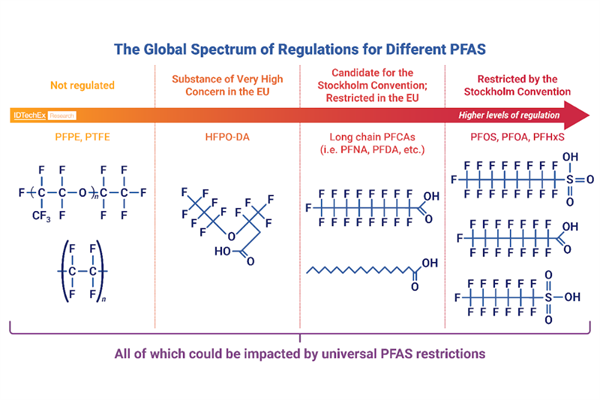
IDTechEx’s companion report, PFAS Treatment 2025–2035: Technologies, Regulations, Players, Applications, explores the technologies and initiatives aimed at detecting and removing PFAS from the environment. The report also assesses efforts to mitigate the long-term damage caused by their widespread use.
Per- and polyfluoroalkyl substances
(PFAS), a large family of chemicals that includes both polymer and non-polymer variants, are widely used across multiple industries, from transport to consumer goods. However, growing environmental and health concerns are prompting increased regulatory scrutiny. A new report by IDTechEx, "Per- and Polyfluoroalkyl Substances (PFAS) 2025: Emerging Applications, Alternatives, Regulations", examines the evolving landscape of PFAS regulation, both at a global level and for specific compounds within the group.
Among the more controversial uses of PFAS is their application in paper and fibre-based food packaging, often promoted as a sustainable alternative to single-use plastics. These materials are typically coated with PFAS to provide resistance to oil and water. However, studies have shown that such coatings can leach into food and persist in the environment after disposal, casting doubt on their ecological credentials.
PFAS are known for their persistence in the environment and their bioaccumulative nature, meaning they do not break down naturally and can build up in water, soil, air, and even the human body. Products containing PFAS contribute to environmental contamination via wastewater discharge and landfill leakage, with traces now being detected in drinking water and air emissions around the world.
The response to these challenges is gaining momentum globally. While many countries have yet to implement restrictions, others are leading the way. In particular, the European Union is considering a comprehensive ban on the manufacturing, sale, distribution and use of PFAS. The draft proposal allows for a few exemptions—namely in pharmaceuticals and certain plant protection products—and may grant temporary waivers for specific applications, with a grace period of either 6.5 or 13.5 years depending on factors such as the availability of safer alternatives.
The EU’s key regulatory committees—SEAC (Socio-Economic Analysis Committee) and RAC (Risk Assessment Committee)—met throughout 2024 to assess the implications of a blanket ban across different sectors. Further meetings are planned for 2025, focusing on uses in lubricants, medical devices, electronics and semiconductors. Their final recommendations, expected to be presented to the European Parliament in 2026, could pave the way for regulations coming into force as early as 2027.
Growing consumer awareness and mounting regulatory pressure are pushing other nations to consider similar bans. These concerns extend far beyond packaging. IDTechEx also explores PFAS usage in sectors such as electric vehicles, ion exchange membranes, thermal management systems in data centres, high-frequency 5G components, and specialised seals and gaskets. In each of these industries, conversations are beginning around the feasibility of phasing out PFAS and finding viable alternatives.